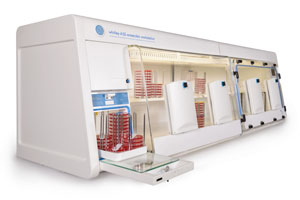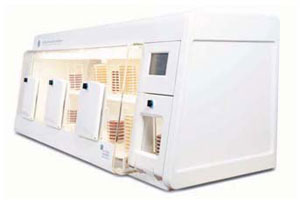
Colony of Actinobacillus actinomycetemcomitans - Image Credit Derren Ready, Wellcome Images
Anaerobes in Dental and Periodontal Disease
Dental and periodontal disease are among the most common chronic infections in adults and can increase the risk for diabetes, stroke, respiratory diseases and cardiovascular disease. Culture and molecular studies have identified more than 400 species of bacteria in different types of dental and periodontal infections, and anaerobes may outnumber aerobic bacteria by a factor of up to 3. An imbalance in the oral microbiota, caused by host and/or bacterial factors, leads to overgrowth of potentially pathogenic microorganisms, with a shift taking place from Gram-positive, facultative microorganisms to predominantly Gram-negative, anaerobic organisms.
The complex mix of microbiota necessitates a reliable anaerobic culture method that enables detection of the very sensitive oxygen-intolerant bacteria. Anaerobic incubation on non-selective media has the potential to greatly improve identification of many species combined with molecular methods such as PCR-based cloning approaches.
Anaerobes’ fastidious nature complicates their isolation from infected sites. Anaerobic culture remains a time-consuming and laborious detection method, so any means of expanding sample number and detection certainty is of clinical interest.

Whitley Workstation A55

Whitley Workstation A35 with HEPA Filtration

Whitley Workstation A45

Whitley Workstation A85 with HEPA Filtration
The Don Whitley Scientific range of anaerobic workstations provides the method of choice for culturing anaerobes:
- Anaerobic conditions are achieved with anoxic nitrogen gas and maintained at minimal gas consumption through the combination of annealed, seamless acrylic shell, sleeve gassing to remove ambient atmosphere, and rapid-entry airlock with mechanical and electrical interlock. Final Traces of oxygen are rapidly removed through the action of the catalyst, which does not have to be baked to be rejuvenated as is the case for other anaerobic chambers. The Anaerobic Conditions Monitor provides accurate, real-time confirmation that there is, indeed, no oxygen present in the chamber, and these data can be downloaded and saved for further analysis and quality control purposes.
- Since the entire cabinet serves as an incubator, the functional capacity of the glovebox is increased because there are no separate internal incubators. The workstations’ large capacity, when compared with a suitable number of anaerobic jars, can actually lead to cost savings of up to 50% over the lifetime of a workstation.
- Integrated humidity control extracts excess moisture from the atmosphere and requires no user maintenance. On the other hand, evaporation has to be minimized during microbiological culture to ensure stability of the media composition. The Don Whitley Scientific Automatic Humidity system reacts dynamically to actual conditions within the chamber, injecting sterile steam to adjust RH to the desired level. The advantages over open containers of water placed in a jar or a glovebox, with regard to contamination and dynamic control of RH, are evident.
- The A35 anaerobic workstation can be fitted with an industry-first HEPA Filtration system to create a particle-free atmosphere exceeding ISO 14644-1 class 3 standards. This feature adds a unique level of product protection by passing the entire atmosphere inside the chamber through the filter every 4 seconds (a total of more than 900 times/hour). Tangential fans circulate air over the catalyst and the heating mats, creating a gentle laminar flow that ensures a consistent anaerobic atmosphere.
- Various workstation sizes are available, to accommodate lab space requirements and sample volume, from the personal-size DG250 (270 plate capacity) to the dual atmosphere A55 (1400 plate capacity).
Microaerophilic bacteria such as Actinomyces actinomycetemcomitans, Campylobacter rectus, and Eikenella corrodens are also implicated in chronic periodontitis. These bacteria require a different atmosphere to thrive, e.g. be detected. For example, Campylobacter spp. requires an atmosphere of reduced oxygen (5%) and increased carbon dioxide (5-10%), and it grows well at a temperature of 42˚ C. The Don Whitley Scientific range of microaerophilic workstations is able to create these specific conditions through differential gas inlet into a closed chamber. Gas levels are sensed and controlled in real time: oxygen can be controlled from 0.1-20% and CO2 is controlled from 0.1-15%. Temperature and humidity are also automatically regulated to the user’s specifications in the workstation. Gas consumption in the Whitley Workstation M35 is the lowest in the industry, using up to 47 times less nitrogen than competitors’ systems.

Whitley Workstation M35
Recent research using the Don Whitley Scientific anaerobic workstations:
| Author | Title | Publication |
|---|---|---|
| Latimer et al. | Antibacterial and anti-biofilm activity of mouthrinses containing cetylpyridinium chloride and sodium fluoride | BMC Microbiology (2015) 15:169 |
| Vartoukian et al. | In Vitro Cultivation of ‘Unculturable’ Oral Bacteria, Facilitated by Community Culture and Media Supplementation with Siderophores | PLoS ONE 11(1): 2016 |
| Forbes et al. | Simultaneous Assessment of Acidogenesis-Mitigation and Specific Bacterial Growth-Inhibition by Dentifrices | PLoS ONE 11(2): 2016 |
| Narendrakumar et al. | Adherence of oral streptococci to nanostructured titanium surfaces | Dental Materials 31, 1460-1468 (2015) |
| Gorman | Structure of the lysine specific protease Kgp from Porphyromonas gingivalis, a target for improved oral health | Protein Sci. 2015 Jan; 24(1): 162–166 |

